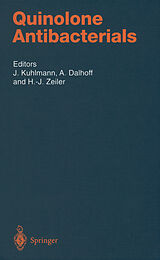Quinolone Antibacterials
Einband:
Kartonierter Einband
EAN:
9783642803666
Untertitel:
Handbook of Experimental Pharmacology 127
Genre:
Medizin
Herausgeber:
Springer Berlin Heidelberg
Auflage:
Softcover reprint of the original 1st ed. 1998
Anzahl Seiten:
512
Erscheinungsdatum:
12.02.2012
ISBN:
3642803660
It has been over 30 years since the first clinically important member of the quinolone class, nalidixic acid, was introduced into medical practice. The modification produced in the quinolone nucleus by introducing a fluorine at the 6-position led to the discovery of the newer fluoroquinolones with enhanced antibacterial activities as compared to nalidixic acid. By now a great deal of preclinical and clinical experience has been obtained with these agents. The intense interest in this class of antibacterial agents by chemists, micro biologists, toxicologists, pharmacologists, clinical pharmacologists, and clini cians in various disciplines encouraged us to summarize the information on the history, chemistry, mode of action and in vitro properties, kinetics and efficacy in animals, mechanisms of resistance, toxicity, clinical pharmacology, clinical experience, and future prospects in one volume of the Handbook of Experimental Pharmacology. As this series deals predominantly with "experimental" characteristics of drugs, our volume is dedicated specifically to quinolones and emphasizes principally their preclinical and clinical phar macological characteristics, despite the existence of several summaries on quinolones. The chemistry of the quinolones is described in detail. The chapter on the mode of action of quinolones reports the conclusive evidence that gyrase is the intracellular target of the quinolones; however, another enzyme, topoisomerase IV, may also be a target for quinolones, and the exact mechanisms by which quinolones act bactericidally are far from being understood.
Klappentext
The quinolones continue to make a significant contribution in the fight against community or hospital acquired infections and add a new dimension of antibacterial therapy. This volume describes in detail the chemistry, mode of action and pharmacodynamics of the quinolones. A lot of effort has been undertaken to optimize structure-activity relationships with the aim of producing more potent drugs with an optimal therapeutic index.
Inhalt
1 History and Introduction.- A. Chemistry.- B. Antibacterial Activity.- C. Oxygen and 4-Quinolones.- D. 4-Quinolone Kinetics and Distribution in Humans.- E. Outlook.- References.- 2 The Chemistry of the Quinolones: Methods of Synthesizing the Quinolone Ring System.- A. Introduction.- B. Methods of Synthesizing the Quinolone Ring System.- References.- 3 The Chemistry of the Quinolones: Chemistry in the Periphery of the Quinolones.- A. Introduction.- B. 1-Position.- C. 2-Position.- D. 3-Position.- E. 4-Position.- F. 5-Position.- G. 6-Position.- H. 7-Position.- I. 8-Position.- References.- 4 Mode of Action.- A. Introduction.- B. Effects on Bacteria.- C. Effects on DNA Gyrase.- D. Mode of Binding.- E. Mechanism of Cell Killing.- F. Conclusions and Future Prospects.- References.- 5 The In Vitro Antibacterial Activity of Quinolones: A Review.- A. Introduction.- B. In Vitro Activity.- C. The Future.- References.- 6 Pharmacokinetics of Fluoroquinolones in Experimental Animals.- A. Introduction.- B. Norfloxacin.- C. Pefloxacin.- D. Enoxacin.- E. Ofloxacin.- F. Ciprofloxacin.- G. Temafloxacin.- H. Tosufloxacin.- I. Fleroxacin.- J. Lomefloxacin.- K. Sparfloxacin.- L. Penetration of Quinolones at Sites of Infection.- References.- 7 Pharmacodynamics of Fluoroquinolones in Experimental Animals.- A. Introduction.- B. Bacterial Killing In Vivo.- C. In Vivo Postantibiotic Effects.- D. Pharmacodynamic Parameters Determining Efficacy.- E. Emergence of Resistance to Fluoroquinolones.- References.- 8 Interaction of Quinolones with Host-Parasite Relationship.- A. Introduction.- B. Effect on Adherence.- C. Effect Against Slowly Growing Bacteria.- D. Effect on Exoenzyme Production.- E. Quinolone-Induced Endotoxin Release.- F. Summary.- References.- 9 Mechanisms of Resistance to Fluoroquinolones.- A. Introduction.- B. Target Site Modification.- C. Reduced Intracellular Accumulation.- D. Reduced Killing.- E. Prevalence of Fluoroquinolone Resistance.- F. Distribution of Resistance Mechanisms.- G. Summary.- References.- 10 Toxicology and Safety Pharmacology of Quinolones.- A. Introduction.- B. Arthropathy.- C. Achilles Tendinitis and Rupture.- D. Nephropathy.- E. Effects on Central Nervous System.- F. Ocular Toxicity.- G. Impairment of Spermatogenesis.- H. Cardiovascular Effects.- I. Possible Mutagenic and Carcinogenic Effects.- J. Phototoxicity.- K. Photocarcinogenicity and Photomutagenicity.- L. Drug Interactions.- M. Metabolic and Nutritional Effects.- N. Conclusion.- References.- 11 Clinical Pharmacology.- A. Introduction.- B. Pharmacokinetics of Fluoroquinolone Antibiotics.- C. Interactions of Fluoroquinolone Antibiotics with Other Drugs.- D. Adverse Reactions of Fluoroquinolones.- References.- 12 Concentration-Effect Relationship of the Fluoroquinolones.- A. Introduction.- B. Pharmacodynamic Data of Antimicrobials as a Basis for Clinical Use.- C. Pharmacokinetic Aspects.- D. Summary and Conclusion.- References.- 13 Clinical Use of Quinolones.- A. Introduction.- B. Urinary Tract Infections and Prostatitis.- C. Gastrointestinal Infections and Traveller's Diarrhea.- D. Respiratory Tract Infections.- E. Osteomyelitis.- F. Skin and Skin Structure Infection.- G. Sexually Transmitted Diseases.- H. Intra-abdominal Infections.- I. Bacteremia and Sepsis.- J. Surgical Prophylaxis.- K. Infections in Neutropenic Patients.- L. Use of Quinolones in Pediatrics.- M. Remarks.- References.- 14 Future Aspects.- A. Introduction.- B. Molecular Structure and Mechanism of Action.- C. Antimicrobial Activity.- D. Bacterial Resistance.- E. Future Use of Quinolones in Pediatrics.-F. Antitumor Potential.- G. New Attitudes.- H. Directions of Future Research on the Quinolones.- References.

Leider konnten wir für diesen Artikel keine Preise ermitteln ...
billigbuch.ch sucht jetzt für Sie die besten Angebote ...
Die aktuellen Verkaufspreise von 6 Onlineshops werden in Realtime abgefragt.
Sie können das gewünschte Produkt anschliessend direkt beim Anbieter Ihrer Wahl bestellen.
Loading...
Die aktuellen Verkaufspreise von 6 Onlineshops werden in Realtime abgefragt.
Sie können das gewünschte Produkt anschliessend direkt beim Anbieter Ihrer Wahl bestellen.
| # | Onlineshop | Preis CHF | Versand CHF | Total CHF | ||
|---|---|---|---|---|---|---|
| 1 | Seller | 0.00 | 0.00 | 0.00 |
